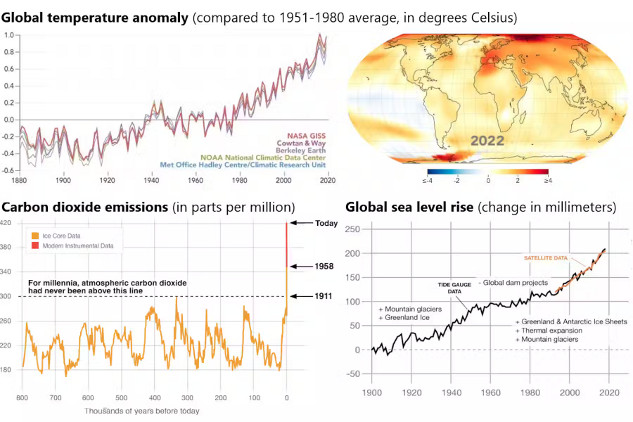
Monster Soup, an 1828 political cartoon by William Heath, shows a woman horrified by a magnified drop of Thames River water. Wellcome Images via Wikimedia
Article Summary:
Addressing climate change may not require everyone to believe in it. Historical parallels, such as the acceptance of germ theory, show that practical actions based on shared interests can lead to significant progress. By focusing on common goals and beneficial practices, humanity can take meaningful steps towards combating climate change. This approach emphasizes the importance of behavior change over belief, highlighting how different motivations can converge to achieve environmental sustainability.

Can Humanity Address Climate Change Without Belief?
by Ron Barrett.
Strange as it may seem, early germ theorists could tell us a lot about today’s attitudes toward climate change.
While researching for a new book about the history of emerging infections, I found many similarities between early debates over the existence of microbes and current debates over the existence of global warming.
Both controversies reveal the struggles of perceiving an unseen threat. Both reveal the influence of economic interests that benefit from the status quo. But most importantly, both reveal how people with different beliefs and interests can still agree on key policies and practices for tackling a global problem.
What you can’t see might hurt you
Seeing is believing, and until the mid-19th century, it was very difficult to see the tiny organisms responsible for our so-called “fever” diseases.
Although the indirect evidence was compelling, many people remained skeptical of “animalcules” – as microorganisms were once called – until the microscope was sufficiently developed. Even then, acceptance was gradual. The once-dominant ideas about disease-causing gases, called miasmsas, persisted for several decades before most people acknowledged that the fevers had a living cause.
Climate change presents similar challenges of visibility. Although everyone can see and feel the weather, it is often difficult to observe its larger patterns and longer trends without the aid of technical charts.

Charts show how global temperature, carbon dioxide emissions and sea level have risen over time. NOAA, NASA, Goddard Space Flight Center/PO.DAAC
Even when people acknowledge the bigger picture, the case for human responsibility is complicated by the fact that the carbon emissions from our engines, like the germ infections within our bodies, are unseen by the naked eye. It is hard to achieve human solutions when the evidence of human cause is invisible.
Economics can outweigh evidence
Adding to these challenges, economic interests often confound scientific recommendations.
In the case of germ theory, early recommendations to prevent the spread of infection included reinstating quarantines at shipping ports and border crossings, thus impeding the international flow of trade.
In the case of climate theory, recommendations to slow global warming include reducing the consumption of carbon-based fuels, thus reducing the flow of oil. These strategies can threaten livelihoods as well as profits, so it is not surprising to find labor unions divided over green initiatives and energy executives spreading misinformation about climate science.
Beliefs and interests need not coincide
But people’s beliefs and interests need not align if everyone finds some benefit in the recommendations.
This was the case in the latter decades of the 19th century, when germ-denying surgeons nevertheless adopted the antiseptic techniques of Joseph Lister.
They did so mainly for the practical reason that their patients fared better under the new methods. But if an explanation was needed, many of these die-hard skeptics claimed Lister’s methods prevented the transmission of miasmas rather than living organisms.
Responding to these claims, Lister stated:
“If anyone chooses to assume that the septic material is not of the nature of the living organisms, but a so-called chemical ferment destitute of vitality … such a notion, unwarranted though I believe it to be by any scientific evidence, will in a practical point of view be equivalent to a germ theory, since it will inculcate precisely the same methods of antiseptic management.”
Lister was more concerned with saving lives than winning arguments. As long as the surgeons adopted his methods, Lister cared little about their justifications. When it came to preventing infection, it was the behaviors rather than the beliefs that counted.
Changing behaviors through complementary interests
The same could be said for global warming: Changing behaviors is more important than changing beliefs.
Case in point, there is a large and growing environmentalist movement among evangelical Christians. Organizations such as Green Faith and the Creation Care Task Force cite Biblical scripture to promote environmental stewardship as a sacred duty.
While many of these groups acknowledge human-based climate change, some of their core beliefs contradict the evolutionary theories that my colleagues and I employ as scientists. But we need not agree about fossils to wean the world off fossil fuels.
The same goes for priorities and economic interests.
A recent national Pew survey found that a large majority of Americans support the development and use of renewable energy. This includes a slight majority of Republicans, though their motives tend to differ from those of Democrats.
Republicans are more likely to prioritize the economic benefits of renewable energy than Democrats, who tend to list global warming as their driving concern.
The economic benefits could explain why red states produce the largest share of America’s wind energy and why three of these states are among the nation’s top five producers of solar energy. Their adoption correlates with the geography of the wind and sun belts, where farmers see favorable returns for producing power and a stable source of income to buffer the price fluctuations of weather-sensitive crops. Livelihood is a powerful motivator.
Finding common ground could change the world
None of these examples address climate change on all its fronts. And among Democrats as well as Republicans, there are different opinions about how fast and how far the transition to renewable energy should go.
But we can take another hopeful lesson from the 19th century: Although people did not agree on all disease-preventing actions, they nevertheless found enough common ground to achieve the greatest mortality decline in recorded history.![]()
Ron Barrett, Professor of Anthropology, Macalester College
Conclusion:
The history of germ theory demonstrates that practical solutions can be adopted even amid skepticism. Similarly, addressing climate change effectively hinges on changing behaviors rather than beliefs. By finding common ground and leveraging shared interests, diverse groups can collaborate on impactful environmental actions. This pragmatic approach underscores the potential for significant progress, regardless of individual beliefs about climate change. Emphasizing practical benefits and mutual goals can pave the way for a more sustainable future.
This article is republished from The Conversation under a Creative Commons license. Read the original article.

Related Books:
The Future We Choose: Surviving the Climate Crisis
by Christiana Figueres and Tom Rivett-Carnac
The authors, who played key roles in the Paris Agreement on climate change, offer insights and strategies for addressing the climate crisis, including individual and collective action.
Click for more info or to order
The Uninhabitable Earth: Life After Warming
by David Wallace-Wells
This book explores the potential consequences of unchecked climate change, including mass extinction, food and water scarcity, and political instability.
Click for more info or to order
The Ministry for the Future: A Novel
by Kim Stanley Robinson
This novel imagines a near-future world grappling with the impacts of climate change and offers a vision for how society might transform to address the crisis.
Click for more info or to order
Under a White Sky: The Nature of the Future
by Elizabeth Kolbert
The author explores the human impact on the natural world, including climate change, and the potential for technological solutions to address environmental challenges.
Click for more info or to order
Drawdown: The Most Comprehensive Plan Ever Proposed to Reverse Global Warming
edited by Paul Hawken
This book presents a comprehensive plan for addressing climate change, including solutions from a range of sectors such as energy, agriculture, and transportation.


























